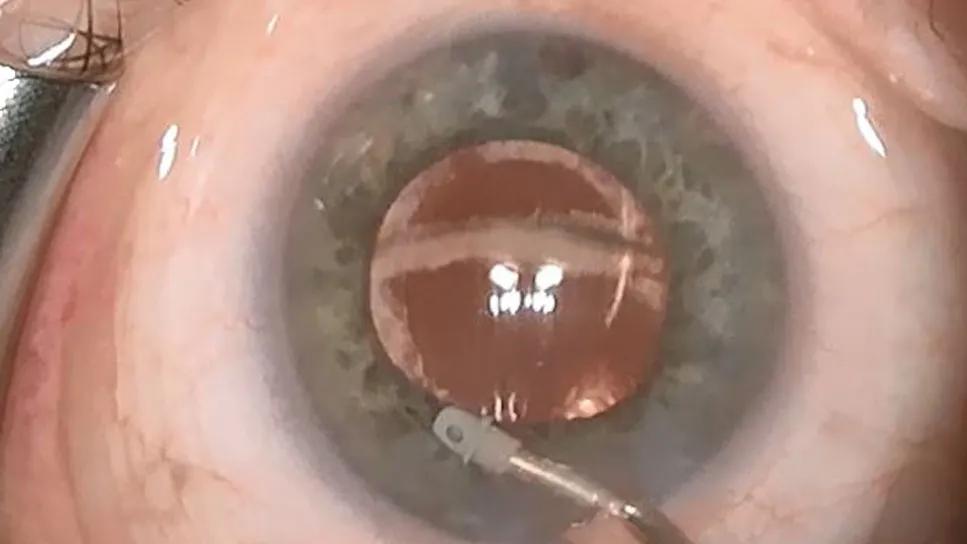Tissue remnants seem unrelated to clinical outcome

A clean, precise excision usually leads to a better surgical outcome, says Ang Li, MD, a glaucoma specialist at Cleveland Clinic Cole Eye Institute. But there might be some leeway with goniotomy to treat glaucoma.
Advertisement
Cleveland Clinic is a non-profit academic medical center. Advertising on our site helps support our mission. We do not endorse non-Cleveland Clinic products or services. Policy
Goniotomy, a minimally invasive procedure to reduce intraocular pressure, is one of the most common surgeries done at the Cole Eye Institute. It is performed by comprehensive ophthalmologists as well as glaucoma specialists and is often done in combination with cataract surgery.
“After this surgery to excise the trabecular meshwork and improve the flow of fluid in the eye, we commonly see a stub of the tissue remaining,” Dr. Li says. “It’s not necessarily a complication, just something we notice. There’s been a lot of discussion about how to remove these remnants and if they need to be removed at all.”
Do trabecular meshwork remnants (also called “stubs” or “hinges”) affect eye pressure and the outcomes of glaucoma surgery? Should eye surgeons take extra steps to remove them, even if they have no clinical impact on patients and are detectable only by gonioscopy or anterior segment examination? “Should we extend surgery just for style points?” asks Dr. Li.
To help answer these questions, Dr. Li and a research team studied the records of patients who had goniotomy at the Cole Eye Institute from 2012 to 2022.
“To study trabecular meshwork remnants, we needed a sizeable group of patients who had the remnant documented,” notes Dr. Li, the study’s senior author. “Although remnants are fairly common after goniotomy, they’re not consistently documented. That might be why the clinical outcomes of these remnants haven’t been studied before. Fortunately, the Cole Eye Institute has a wealth of documented data to review.”
Advertisement

In the retrospective study recently published in Ophthalmology Glaucoma, researchers reviewed 690 eyes that had goniotomy as a treatment for glaucoma. Only 44 (6.4%) had a trabecular meshwork remnant reported within one month after surgery.
Both groups of patients with and without a remnant recorded a significant reduction in intraocular pressure (IOP) after surgery (P < 0.0001). IOP at final visit was similar between the two groups. However, compared to patients without a remnant, patients with a remnant:
When propensity matched according to demographic and intraoperative variables, patients in both groups still showed a significant reduction in IOP up to 36 months after surgery (P < 0.0001). Final visit IOP and number of glaucoma medications used were similar between the groups.
“This suggests that the concern for pigment shedding due to TM [trabecular meshwork] remnants or TM reattachment is either nonexistent or insufficient to lead to a clinically meaningful difference in IOP outcome within the timeframe of this study,” wrote the authors. They recommend future studies to evaluate whether size and pigmentation of remnants affect outcomes.
“For now, we found that trabecular meshwork remnants don’t really affect short-term or long-term IOP outcomes, which is reassuring,” Dr. Li says. “If we leave a stub behind, it doesn’t appear to cause secondary scar-tissue formation or pigment dispersion that can cause clogs and decrease your success rate. Remnants seem to be unrelated to clinical outcome.”
Advertisement
In addition, the researchers identified three factors associated with remnant formation:
Trabecular meshwork remnants usually are not perceived by the patient, says Dr. Li. They are not visually significant and cannot be seen in the mirror by the patient.
“Our study suggests that these remnants really don’t have any clinical significance,” she says. “Their presence does not affect goniotomy outcomes, so they do not require more medical or surgical intervention.”
Advertisement
Advertisement

Prescribing eye drops is complicated by unknown risk of fetotoxicity and lack of clinical evidence

A primer on MIGS methods and devices

7 keys to success for comprehensive ophthalmologists

From medication to laser treatment to surgery

Minimally invasive surgery is effective for uveitic and steroid-induced glaucoma too

Registry data highlight visual gains in patients with legal blindness

A look at emerging technology shaping retina surgery

Study is first to show reduction in autoimmune disease with the common diabetes and obesity drugs